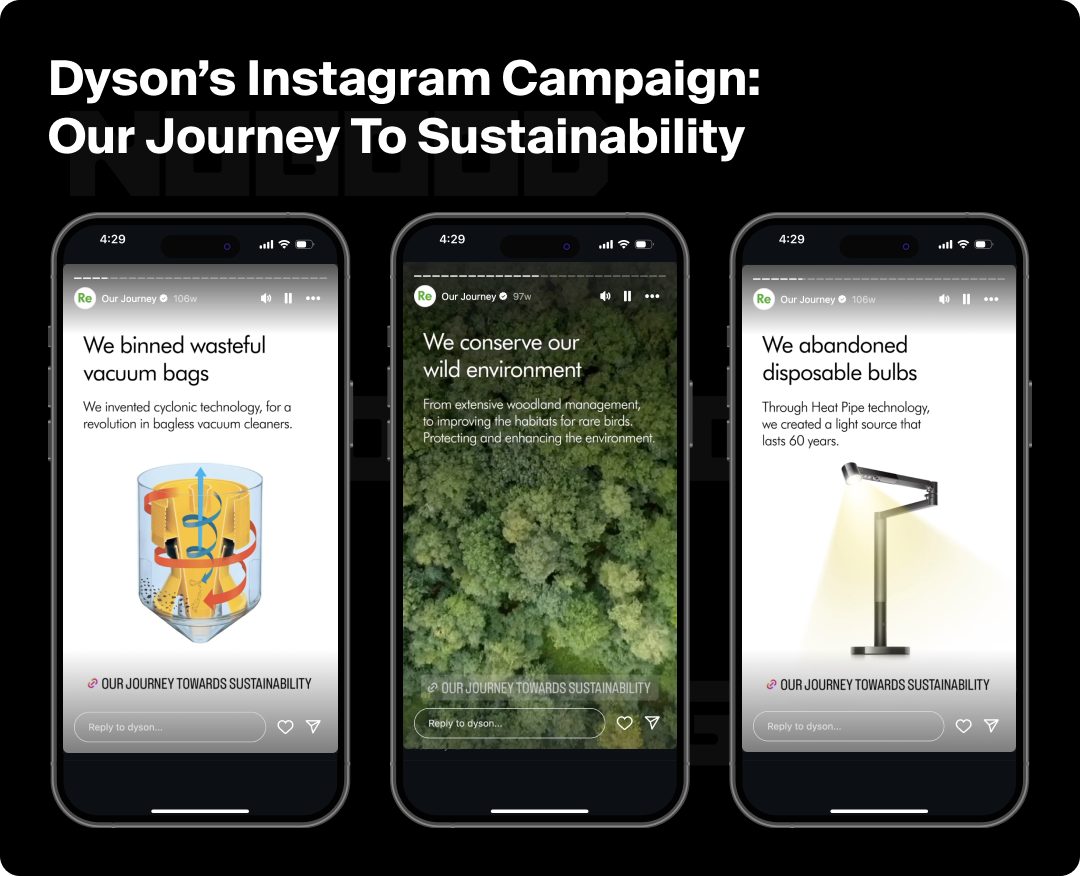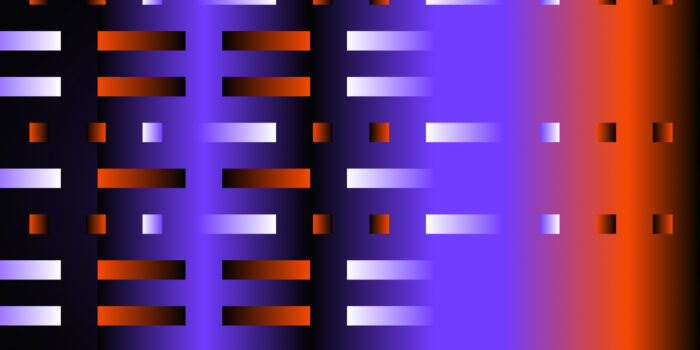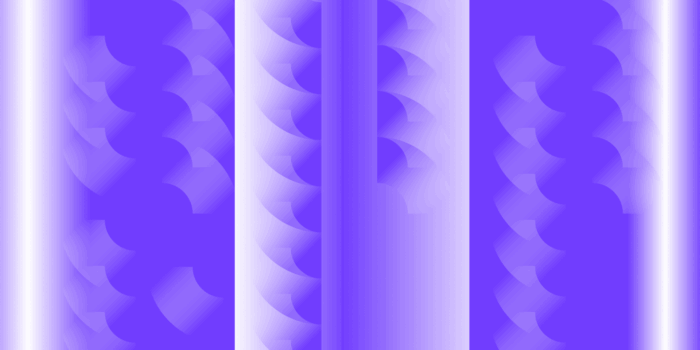From vacuum to vanguard. Dyson, a British born technology company, is a remarkable testament to transformative brand marketing. This journey began with a bold step: modernizing product design to stand out in a crowded market. This design evolution laid the foundation for a larger rebranding effort that positioned Dyson as a leader in innovation and sophistication.
Over recent years, the brand has emerged as a market leader through four pivotal strategies: revolutionizing the ordinary into luxury, social media mastery, immersive retail experiences and sustainability to drive competitive edge. This blog examines how each strategy fuelled Dyson’s brand evolution, cementing its status as a symbol of innovation and sophistication in the home appliance, beauty, and broader tech industries.
Revolutionizing the Ordinary into Luxury
Product Design
At its core, Dyson is a household appliance brand – ordinary and uninspiring. They have a simple mission: “Solve the problems that others ignore.” But how did this brand manage to evolve mundane products into coveted, high-tech innovations?

Renowned now for its cutting-edge technology and sleek design, Dyson has redefined the aesthetics of household appliances, manufacturing them to be objects of desire. This shift began with a deliberate effort to physically reimagine product design.
Dyson’s engineers adopted a “form follows function” philosophy, ensuring every color, material and finish not only celebrated functionality but elevated visual appeal. From the transparent cyclone tech in vacuums to minimalist, futuristic bladeless fans and hair dryers, every product embodies a commitment to efficiency with modern architecture.
The driving mentality behind this particular success is Dyson’s relentless investment in physical innovation. By merging engineering excellence with standout design, Dyson has shattered expectations of how household appliances can look and, more strikingly, what they feel like.
Dyson pours an impressive £9 million per week into research and development (R&D) and plans to double its product range by 2025 with a £2.7 billion investment. That’s nearly half of its profits reinvested into innovation, showcasing an intentional commitment to pushing technological boundaries.
This isn’t just about tweaking existing products; it’s about reimagining what’s possible. These cases illustrate Dyson’s relentless pursuit of innovation in product design.
1. Household Appliance Sector: Dyson V15 Detect Vacuum
Dyson’s most intelligent and powerful vacuum, featuring laser dust detection to reveal hidden debris, Acoustic Dust Sensing to measure and count microscopic particles, and advanced anti-tangle technology. These features provide scientific proof of a deep clean, making it a leader in home cleaning innovation.
2. Beauty Tech Sector: Dyson Airwrap Multi-Styler
The Airwrap revolutionized hair styling by using the Coanda effect to style hair without extreme heat, reducing damage while achieving professional results. Its versatility with multiple attachments and intelligent heat control has set a new standard in beauty technology, making it a status symbol for consumers seeking both performance and protection.
3. Wearable Tech Sector: Dyson Zone Headphones with Air Purification
Combines high-fidelity audio with advanced air purification technology, tackling urban challenges like noise pollution and poor air quality. Its detachable visor delivers purified air while maintaining comfort, making it a groundbreaking wearable device for health-conscious urban dwellers.
From AI and robotics to cutting-edge new battery tech, global R&D centers are reshaping the future of beauty tech, household appliances and wearable tech. These efforts have proven to propel Dyson ahead of the curve while delivering smarter, more sustainable solutions for customers.
Premium Pricing
While a brand’s progression into luxury is a multifaceted approach, premium pricing alludes to the scarcity, quality, status and all around feeling of exclusivity that luxury brands offer customers.

Dyson has committed to a pricing strategy that sets them apart from competitors, positioning products as premium items that deliver high-end value. Here are five examples of how Dyson products level up from their rivals.
Dyson vacuums are priced between $300 and $1,050, with flagship models like the Dyson V15 Detect retailing for $750. In comparison, Shark vacuums range from $100 to $500, and other brands like Tineco offer similar features for as low as $300, making Dyson’s top-tier models costing up to double or triple the price of competitors.
Famed Dyson beauty products, such as the Supersonic hair dryer ($569), Airwrap multi-styler ($599) and Airstrait straightener ($499) are priced significantly higher than competitors like the Shark FlexStyle, which retails for $299-$330 – a difference of up to 100%.
Dyson’s breakout wearable tech, Zone air-purifying headphones, are priced at approximately $949. This is significantly higher than standard noise-canceling headphones from brands like Sony or Bose, which typically range from $300 to $400. Expensive pricing leans on the product’s unique combination of air purification and audio technology, setting it in a niche category.
The brand’s pricing strategy is not just about charging more to label themselves as luxury; it’s rooted in solving real, often-ignored problems with radical engineering. The bagless vacuum cleaner addressed the frustrating loss of suction that plagues traditional vacuums. The bladeless fan reimagined home cooling by eliminating fast-spinning blades, making it safer and easier to clean.
Even the air-purifying headphones, a product few asked for, tackle rising urban air pollution and noise, simultaneously mending two invisible stressors of modern life. These aren’t just gadgets; they’re solutions to everyday problems that most brands never thought to solve directly.
What sets Dyson apart is its relentless pursuit of groundbreaking ideas through rapid prototyping and iterative design. Challenging conventional designs and delivering disruptive solutions has solidified Dyson’s reputation as a leader in technological innovation and justifies their stance on premium pricing.
Dyson also leverages exclusivity to reinforce its luxury status. By avoiding discount-driven promotions and maintaining controlled distribution through its website and Demo stores, Dyson ensures that purchasing its products feels like an exclusive experience. This strategy appeals to affluent consumers who prioritize quality and innovation over cost savings.
Curated customer experiences further supports the brand’s pricing. Customers don’t just buy an appliance. They buy into a brand that promises excellence in tech, reliability, and exclusivity.
The Glow-Up Strategy: Aspirational Social Marketing That Clicks
While product design transformed appliances into status symbols, their aspirational marketing approach elevated these products further by framing them as engineering and design masterpieces. If Dyson could make vacuums become embraced as sleek, high-performance objects of desire, they could bridge the gap between functionality and luxury across their roster of other products.
Typically, feeding consumer desire is a strategy reserved for industries like jewelry, beauty, or automotive, not household appliances. Yet Dyson has defied convention, proving that even the most mundane products can become a dream when strategically marketed this way.
Aspirational marketing goes beyond solving a problem. It taps into who consumers want to be. Dyson doesn’t just promise cleaner floors; it sells the idea of elevated living through engineering excellence. This mirrors the strategy often seen in luxury automotive ads, where performance meets status symbolism. By positioning its products as lifestyle upgrades, Dyson makes people forget their problems and crave the feeling of a life that looks as good as it feels.
Much like beauty brand strategies, Dyson’s social media strategies promote a feeling. Visual storytelling mirrors emotional arcs; think before-and-after reveals, glowing testimonials, and creator content that blends utility with allure. It’s less, “Here is our product you should buy,” and more, “Don’t you want to feel like this?”
A prime example of this is the viral Dyson Airwrap. While a hair tool at its core, the social campaign surrounding it felt like a launch of a brand new beauty essential. The keyword there? Essential.
The social storytelling made the audience feel like they needed this tool. Tutorials from influencers, dramatic styling transformations, and sleek, editorial-style content helped position the Airwrap as not just effective but desirable. It gave everyday people access to salon-level results at home, just as a premium foundation promises professional-grade skin, or a fragrance promises confidence in a bottle.

Dyson invests heavily in user-generated content, influencer collaborations, and educational videos that feel personal, not pushy. The message is consistent: “We know our audience is smart and selective – so we’ll show, not tell.” This content strategy leans into trust, not hype, positioning real users and creators as the storytellers. And it works.
Viral social media marketing campaigns for products like the Airwrap and Supersonic hair dryer have only amplified this methodology. These launches are more than product drops; they’re multi-platform storytelling moments, designed to communicate the innovation behind each product in ways that feel aspirational yet grounded.
If you scroll through Dyson’s social feeds or listen to a handful of clips, you’ll notice how effortlessly both customers and brand voices explain the products’ value. The benefits are articulated in simple, human terms: faster drying, less heat damage, salon-quality results at home.
By partnering with influencers, showcasing real-world transformations, and emphasizing the ease of design benefits – like faster drying with less heat damage – Dyson crafts a narrative that resonates. Its storytelling with substance turns functional features into emotional value. Over time, this approach doesn’t just build hype; it builds credibility, transforming satisfied customers into vocal brand advocates and fueling viral growth through authenticity.

This social strategy built trust, desire, and community. Despite its $500+ price tag, the Dyson Airwrap sold out globally, with waitlists at Sephora and Ulta exceeding 100,000 people. On TikTok alone, #DysonAirwrap has amassed over 2.9 billion views, fueled by influencer tutorials, viral dupe debates, and everyday users sharing real results.
According to Influenster reviews, user-generated content and peer recommendations held more sway than traditional ads, proving that authentic storytelling was the engine behind conversion. Dyson didn’t need to shout. By showing instead of selling, the brand turned functional design into an aspirational lifestyle – and its customers into advocates.
Experiential Marketing: How Dyson Creates Immersive Customer Experiences
While Dyson’s digital presence builds desire, its immersive retail strategy seals the deal. The brand’s demo stores and immersive pop-up experiences invite customers to interact with products firsthand—test-driving vacuums on various surfaces or styling their hair with expert guidance using the Airwrap and Supersonic. These spaces aren’t just showrooms—they’re sensory playgrounds designed to turn product education into a luxury experience.
Dyson’s in-store specialists function more like consultants than salespeople, offering personalized demos, styling sessions, and tailored recommendations. This community-centric service deepens brand trust, making customers feel supported, not sold to. In a category often driven by specs and utility, Dyson creates a retail journey that feels premium, human, and undeniably memorable.

All of these touchpoints – from hands-on demos to consultative service – reinforce a sense of care, expertise, and quality that builds trust beyond the transaction. That trust becomes loyalty, with customers returning not just for the product, but for the elevated experience that comes with it.
Green Marketing: Sustainability To Drive Competitive Edge
Dyson’s board and sustainability team drive the brand’s long-term focus on sustainable engineering and energy efficiency. Their design philosophy prioritizes longevity, incorporating durable materials, efficient digital motors, and easily replaceable parts to reduce waste over time.The company aims to be fully carbon neutral across operations and its supply chain by 2030, aligning with the escalating consumer demand for eco-conscious brands. From recyclable packaging to product pages that spotlight sustainability wins, Dyson ensures that progress is made and shared.

Green marketing is subtly weaved into short-form video language, copywriting and overall brand product storytelling. Innovations like the Airblade hand dryer exemplify this, using up to 87% less energy and producing 85% less CO₂ than traditional alternatives.
Dyson’s design ethos of “doing more with less,” highlights products that are both high-performance and resource-efficient. By framing sustainability as a core value, not an add-on, Dyson builds trust and positions itself as a forward-thinking, environmentally responsible brand.
Wrapping Up (Literally) Dyson’s Brand Story
Dyson’s journey shows us what’s possible when smart design meets smart storytelling. The success of a brand depends on both elements working together; neither can thrive without the other. This isn’t just a brand that makes vacuums or hair tools – it’s a brand that has reimagined everyday products into objects people actually get excited about.
Through sleek innovation, immersive retail, and marketing that feels human, Dyson has managed to make tech feel sexy. Marketing efforts make customers believe buying Dyson products is a strong investment towards a smarter future, both for themselves and the planet.
In a world full of endless options, Dyson stands out by making the ordinary feel extraordinary and by turning customers into loyal fans who keep coming back for more.








Loved this deep dive! I love how they’ve always made everyday products feel like something you want to show off. It’s not just about great engineering, it’s how they tell the story around it. Makes you wonder how many other boring product categories are just waiting for their “Dyson moment”.